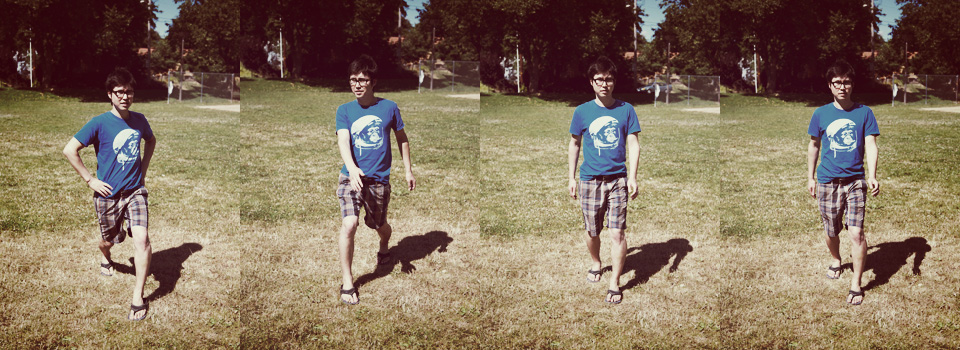
In this guide I’m going to show you how to learn and practice Namba Aruki, a walking style from the Edo period (1603-1868) that is said to be more efficient than how you walk right now. Sure, you’ll look like an idiot walking like this out in public, but who cares if you get to walk like a samurai, right?
How You Walk Right Now
Normal people walk by swinging their right arm and left foot at the same time and vice versa. When you do this, you’re twisting your upper body and hips an unnecessary amount. They’re actually going against each other here, squishing the side you’re stepping with.
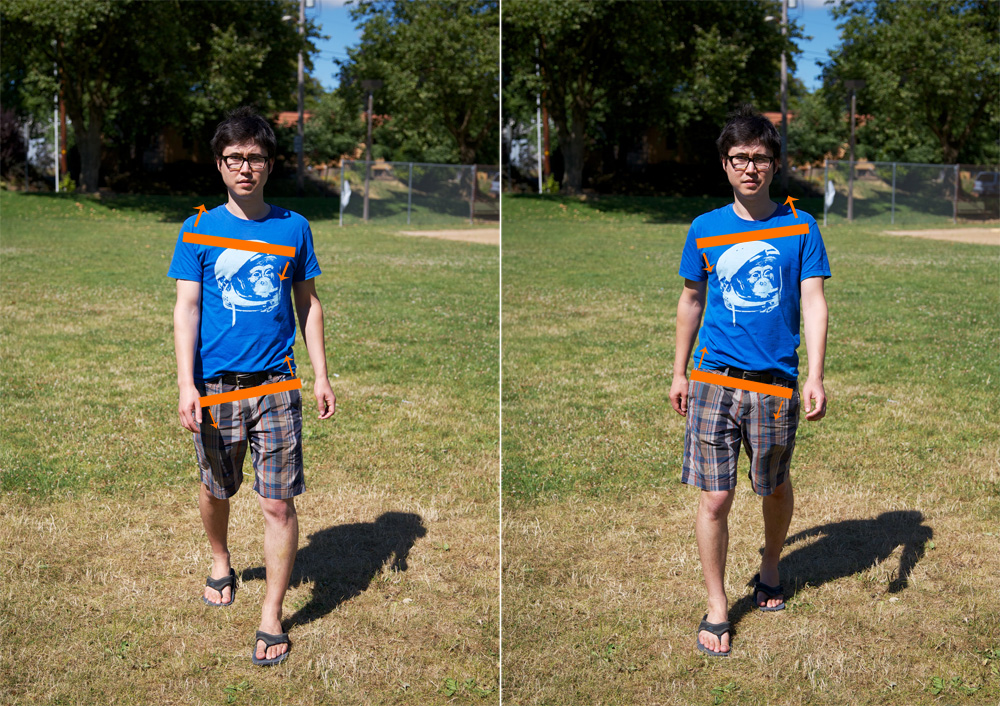
It also causes you to push off using your feet with each step which means you’re using a tiny muscle to lift your entire body (this gets tiring). Normal walking is basically you falling forward over and over again. The only reason you don’t fall on your face every time you take a step is because you catch yourself with your foot, over and over again.
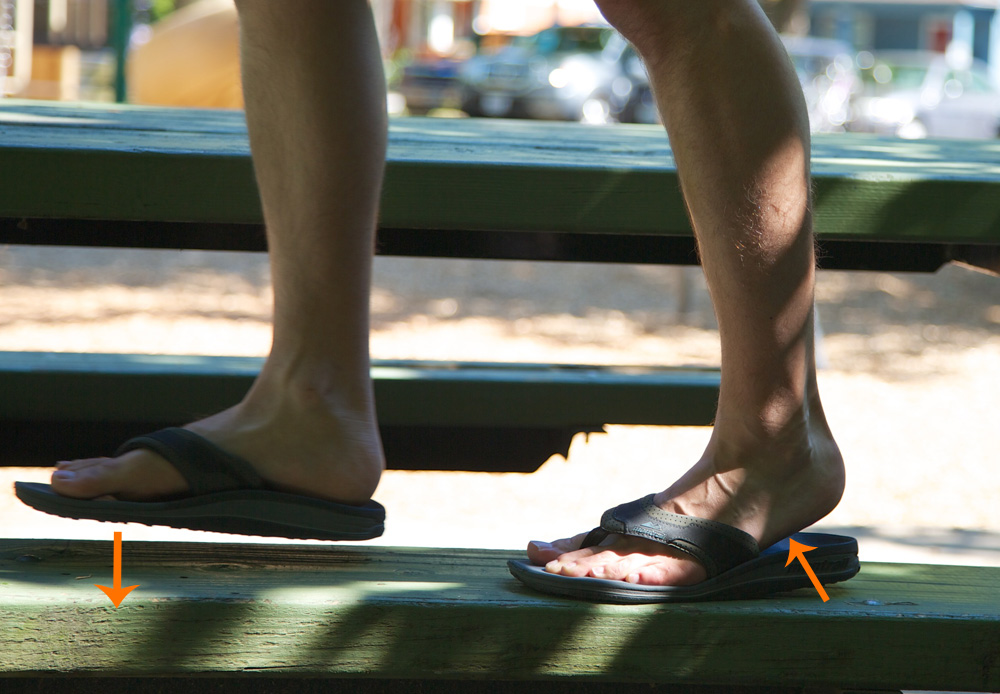
This is a lot of energy being spent!
How Namba Aruki Works
Namba Aruki on the other hand makes your movements more efficient. It will feel strange at first, but essentially you’ll be walking in a way that makes your upper body more stable, keeps your hips straight forward as you walk, makes you more controlled, and doesn’t require you to lift your entire body with your feet. This type of walk is good for people who do Japanese martial arts, wear kimonos and/or swords, and enjoy hiking. Most likely, the hiking part will be the most applicable to you. In fact, some of the theory behind Namba Aruki resembles the rest step which is used to climb up steep hills with very little effort at all.
Learning To Namba Aruki
We’re going to use a step by step program to make you a Namba Aruki master. This won’t happen in one hour, one day, or one week, but it will happen over time. If you practice this for around three months you should be able to see the difference and possibly be able to apply this walking style to your normal walking style (if you don’t want to look like a weirdo walking around town).
Step 1: Big Steps
The first step is to over-exaggerate your steps. This isn’t at all how you’ll be walking when after Namba Aruki becomes more comfortable, but it will teach your body the basic motions that it needs to know in order to get used to it.
To begin, You’ll be taking really big steps, almost like lunges. Put your hands on your hips, and do the following.
- Step with your right foot.
- Turn your hips towards your right leg, so it’s almost like you’re trying to face your upper body to the right. In reality, this will be straightening your upper body out so you’re facing straight forward. When you walk normally, your upper body would turn to the left. This is to counteract this though it’s a bit exaggerated right now.
- Swing your elbows (hands still on your hips) to the right as well. This will help you to turn your body.
- Step with your left foot and switch everything. Upper body should turn to the left (towards your left leg). Continue walking like this.
As for visuals, it should look something like this:

Make sure you’re really torquing your entire upper body to the side of your forward foot. This will help you to complete the next step. I’d recommend practicing this for a few days, at least. It will build the muscles necessary to do Namba Aruki properly if you don’t have them already. You might feel a little bit of soreness in your hip muscles (who knew they existed, right?). If you do, you’re doing things right.
Step 2: Swing Your Arms
Now we’re going to do the same thing as before, except this time you’re going to swing your arms. Since it’s Namba Aruki, you have to swing the same arm as the foot that’s forward. This will feel awkward at first, especially since you’ll be taking big steps still. This will be difficult to do, but it will make the next step easier. So, do exactly what you did in Step 1, except this time swing your arms.
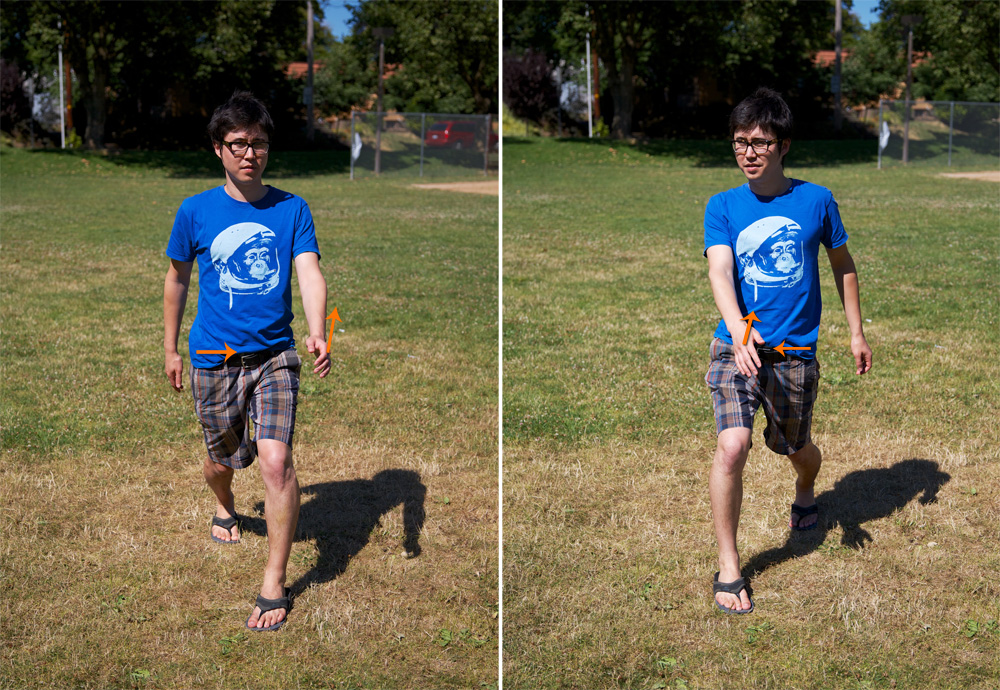
Remember, same hand, same foot. Practice this for a few more days until it becomes comfortable.
Step 3: Bring It In
Now it’s time to make it a bit smaller so it’s more like normal walking. You still want to swing the same arms as the foot that’s forward, but don’t swing it too much. Nice and small, like normal walking (but Namba style). Also turn your hips a little less too. Now that you’ve gotten used to this (and hopefully stretched your hips out) you can turn more subtly. The goal should be to turn your hips just enough so that they don’t actually move at all. There is a skill in doing this, for sure. When you do this in front of a mirror, your hips should always remain facing directly forward. Same with your shoulders. It’s as if your upper body doesn’t move that much at all.

You’ll also want to place each step before doing the next one. This means you aren’t “falling” forward as you would with normal walking. You’re stepping, placing, and then lifting your back foot to do your next step. Take it nice and slow at first, but as you get used to this you should feel a lot more stable when you’re walking. Each step is a piece of art. Place your foot solidly before moving on to the next step.
Step 4: Speed Up
Once you’ve gotten this down, it’s time to speed up. While it’s going to be hard to do sprints in Namba style, it’s definitely possible to jog or even run once you get good at it. Practice at a normal walking speed at first, then slowly increase the speed as each level begins to feel “natural” (just like normal walking). Try to get up to a jogging speed and practice this for two or three months. You’ve been walking one way your entire life, so it will certainly take some practice to get to this point, but once you do you will begin to feel the rewards.
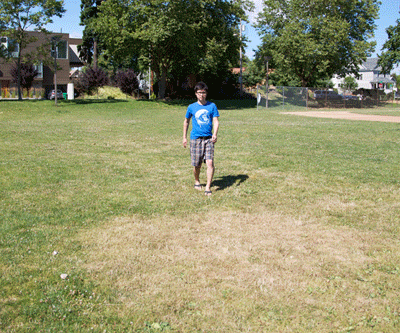
Step 5: Test It Out
Got a hike you want to go on? Have a long walk through downtown planned? Want to join the armies of old people who power walk through the mall before it opens? Now it’s your turn. After this walk has become natural feeling to you (and only after) come up with a test to see how well it works. Hikes are the best, I think, because you get all kinds of different elevations (it’s great for walking up hills and mountainsides). Either you’ll find you need more practice or you’ll find it’s a really nice way to walk for long distances, despite how silly it may look.
If you’re finding the Namba walk difficult, take a look at your hips. Make sure you’re not turning them too far (only step 1 and 2 are exaggerated). Your upper body should just remain facing forward at all times, and your hips and shoulders should be level. Check yourself in front of a mirror to see if any of these things are happening. If they are, correct them and practice some more.
If you actually do go through with the Namba Aruki practice regimen and you do this for a few months, be sure to let me know how it goes for you! I’m always interested in how these crazy theories pan out on other people besides myself.
What Is Namba Aruki?

Namba Aruki is the running style of the express runners (hikyaku 飛脚) during the Edo Period (1603-1868) whose job it was to run messages quickly and efficiently between Edo and the other provinces. Usually they would travel in pairs, one having a pole with a box or package on the end, and another that had a pole with a lantern on it inscribed with the characters “official business.” Needless to say, communication was key to an effective government, so these express runners had to be very, well, express. They would regularly run from Edo to Kyoto in 6-8 days. Considering that’s approximately 300 miles (~480km) on foot, I’d say it isn’t all that shabby. I would certainly subscribe to their Hikyaku Prime program if they had one.
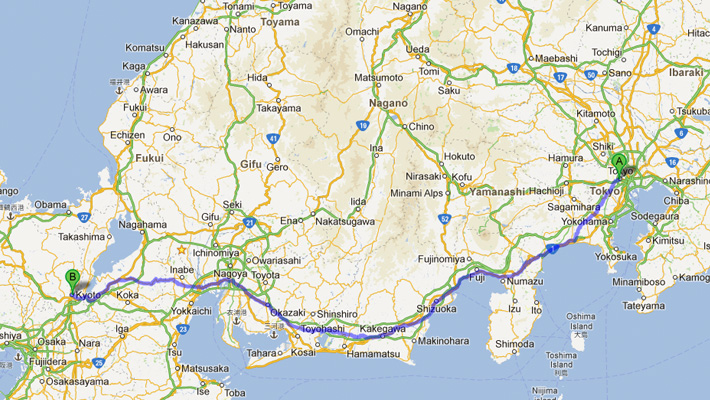
Of course, doing all this running must have been tiring for them. That being said, there was a lot of time and opportunity to figure out a better way of running. Something more efficient… something that would get them to their destination faster overall… something a little more namba, perhaps?
But it wasn’t just the express runners who used this style of walking. If you’re wearing a kimono Namba Aruki will also make it so it doesn’t get rumpled up (because you don’t move your hips or upper body back and forth like with normal walking). Also, if you have a sword (aka you’re a samurai and/or Tom Cruise) at your hip walking in the Namba style will prevent the sword from swinging side to side, which would get irritating after a while (and make it harder to draw while you’re running). Lastly, if you’re wearing geta and walking through the muddy streets, this style of walking would prevent you from splashing said mud up the back of your hakama or pants, or even onto other people. So, even beyond the express runners there were many reasons for people to walk this way in Edo era Japan.
Benefits Of Namba Aruki
So why should you start walking in a way that makes you look like a fool? Are there actually benefits to this? In several martial arts, particularly Japanese ones, the benefits of Namba Aruki are more obvious. Kendo and Aikido in particular get a big boost from learning this because many of the basic footwork actually revolves around namba aruki (though very few dojos teach it nowadays for some reason).
But what about your regular day-to-day life? What if you want to get up and namba aruki all the way to the 7-Eleven across the street to get your Wild Radiation Slurpee™? You’re in luck, my friend. Even you can benefit from this special Edo-style walk.
According to the Japanese Wikipedia page on Namba Aruki, you’ll get all this and more with your Namba Aruki Slurpee.
- Longer lasting stamina by twisting your body the bare minimum.
- Stable posture with reduced twists in the upper half your body
- No wasted energy and increased explosiveness (when you push off to walk or run, you sicko!).
- More power by moving one arm, hip and leg at the same time, like the wooden pole used by sumo wrestlers in training.
- Less strain on your body by climbing steep slopes or stairs in the Namba running style.
So there you have it. So many good things happen to people who are willing to look like a weirdo while walking around in public. If this isn’t your cup of tea, perhaps incorporating namba aruki training into your sports regimen is? Namba Aruki in modern sports is got fairly in Japan for a while and still is to a certain extent.
Namba Aruki In Modern Sports
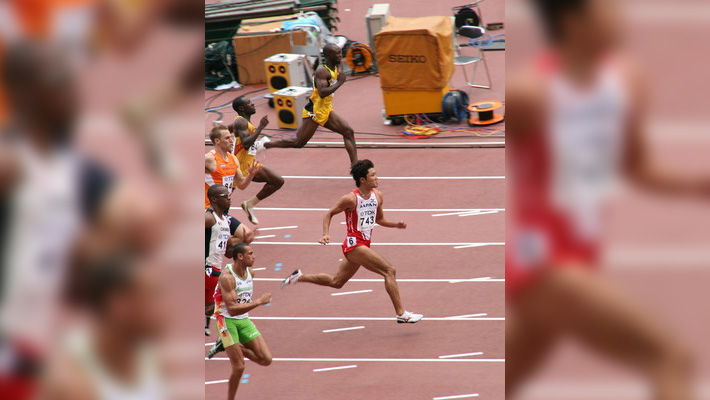
There are a number of professional athletes from Japan who trained with Namba Aruki in mind and ended up doing pretty well. Perhaps the best known is Shingo Suetsugu who set the Asian record for the 200 meters at 20.03 seconds during the Japanese National Championships. But he as well as other runners who incorporate Namba Aruki only do this walk to a certain extent. The idea is to train with Namba Aruki and apply the concepts of efficiency into the regular sprinting, not to run in a true Namba Aruki style.
Several successful Japanese basketball teams also incorporated Namba Aruki in their training. For example, the Toho High School Basketball Team was selected to participate in the inter high school meet, representing Tokyo. You’ll hear about other athletes using Namba Aruki as well, to varying degrees.
That being said, these examples aren’t “true” Namba Aruki styles. They were just incorporating what they learned from it into what they normally do. Suetsugu is quoted as saying that he “had been consciously thinking about the movements of the Namba style while running and this lead to an increased awareness of the running style.” So, while beneficial he wasn’t actually out there running by swinging the same hand and foot at the same time. A shame. That would be fun to see.
Still, you can see why some athletes think about Namba Aruki in Japan. It is efficient. And while it doesn’t necessarily lend itself to modern sports, a lot of the ideas behind it does, meaning you could do the same thing for yourself, too.
A New Namba Aruki Era?
It’s not entirely known how many people walked like this back in the day. Some people think that quite a few people used Namba Aruki, others think it was more of a special and practiced movement style done by a small percentage of the Edo population. Based on what I’ve read, I tend to agree more with the second theory. I think some of the higher class, samurai, and express runners used Namba Aruki. It definitely helps a lot with kimonos and swords, which matches up with the higher class / samurai statement from before.
There are several theories on why Namba Aruki became extinct, too. One theory is that it disappeared with the introduction of conscription where the marching style being used was that of the Western military training (opposite hand and foot swing, body twists). Others say it is due to “Westernization,” though this could simply be part of the”critique of the modern/Western” going on at the time. What we do know is that in film and photographs taken in the early 1900s, nobody is using Namba Aruki, but beyond that it’s not too well documented. Perhaps it came to an end when swords, kimonos, and geta became less popular. It just wasn’t as useful anymore, and the effort to practice it outweighed the benefits you’d receive.
So, the question remains. Was Namba Aruki something that a small percentage of people did (probably), or is it an ancient walking style many people did that disappeared with the dodo? Certainly if I got my hands on a time machine, this would be one of the last things I’d bother checking out.
I for one hope to bring Namba Aruki back, though, which is why I wrote this guide on how to learn and practice Namba Aruki. Perhaps hipsters will pick it up?
I hope you go out there and start walking in Namba style now. It’s really quite fun and definitely feels very different. I’ve been practicing this for a couple months now and the girlfriend absolutely hates walking around with me in public, so mission accomplished, I suppose. Oh, I also feel less tired when I walk long distances. That’s pretty good too. Why don’t you give it a try and see how it works for you? Be sure to let us know, too!
